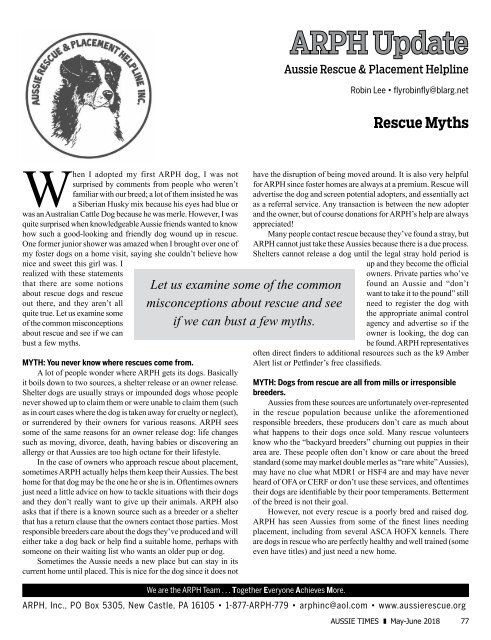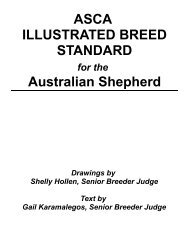2018 May June
Create successful ePaper yourself
Turn your PDF publications into a flip-book with our unique Google optimized e-Paper software.
ARPH Update<br />
Aussie Rescue & Placement Helpline<br />
Robin Lee • flyrobinfly@blarg.net<br />
Rescue Myths<br />
When I adopted my first ARPH dog, I was not<br />
surprised by comments from people who weren’t<br />
familiar with our breed; a lot of them insisted he was<br />
a Siberian Husky mix because his eyes had blue or<br />
was an Australian Cattle Dog because he was merle. However, I was<br />
quite surprised when knowledgeable Aussie friends wanted to know<br />
how such a good-looking and friendly dog wound up in rescue.<br />
One former junior shower was amazed when I brought over one of<br />
my foster dogs on a home visit, saying she couldn’t believe how<br />
nice and sweet this girl was. I<br />
realized with these statements<br />
that there are some notions<br />
about rescue dogs and rescue<br />
out there, and they aren’t all<br />
quite true. Let us examine some<br />
of the common misconceptions<br />
about rescue and see if we can<br />
bust a few myths.<br />
MYTH: You never know where rescues come from.<br />
A lot of people wonder where ARPH gets its dogs. Basically<br />
it boils down to two sources, a shelter release or an owner release.<br />
Shelter dogs are usually strays or impounded dogs whose people<br />
never showed up to claim them or were unable to claim them (such<br />
as in court cases where the dog is taken away for cruelty or neglect),<br />
or surrendered by their owners for various reasons. ARPH sees<br />
some of the same reasons for an owner release dog: life changes<br />
such as moving, divorce, death, having babies or discovering an<br />
allergy or that Aussies are too high octane for their lifestyle.<br />
In the case of owners who approach rescue about placement,<br />
sometimes ARPH actually helps them keep their Aussies. The best<br />
home for that dog may be the one he or she is in. Oftentimes owners<br />
just need a little advice on how to tackle situations with their dogs<br />
and they don’t really want to give up their animals. ARPH also<br />
asks that if there is a known source such as a breeder or a shelter<br />
that has a return clause that the owners contact those parties. Most<br />
responsible breeders care about the dogs they’ve produced and will<br />
either take a dog back or help find a suitable home, perhaps with<br />
someone on their waiting list who wants an older pup or dog.<br />
Sometimes the Aussie needs a new place but can stay in its<br />
current home until placed. This is nice for the dog since it does not<br />
Let us examine some of the common<br />
misconceptions about rescue and see<br />
if we can bust a few myths.<br />
We are the ARPH Team . . . Together Everyone Achieves More.<br />
have the disruption of being moved around. It is also very helpful<br />
for ARPH since foster homes are always at a premium. Rescue will<br />
advertise the dog and screen potential adopters, and essentially act<br />
as a referral service. Any transaction is between the new adopter<br />
and the owner, but of course donations for ARPH’s help are always<br />
appreciated!<br />
Many people contact rescue because they’ve found a stray, but<br />
ARPH cannot just take these Aussies because there is a due process.<br />
Shelters cannot release a dog until the legal stray hold period is<br />
up and they become the official<br />
owners. Private parties who’ve<br />
found an Aussie and “don’t<br />
want to take it to the pound” still<br />
need to register the dog with<br />
the appropriate animal control<br />
agency and advertise so if the<br />
owner is looking, the dog can<br />
be found. ARPH representatives<br />
often direct finders to additional resources such as the k9 Amber<br />
Alert list or Petfinder’s free classifieds.<br />
MYTH: Dogs from rescue are all from mills or irresponsible<br />
breeders.<br />
Aussies from these sources are unfortunately over-represented<br />
in the rescue population because unlike the aforementioned<br />
responsible breeders, these producers don’t care as much about<br />
what happens to their dogs once sold. Many rescue volunteers<br />
know who the “backyard breeders” churning out puppies in their<br />
area are. These people often don’t know or care about the breed<br />
standard (some may market double merles as “rare white” Aussies),<br />
may have no clue what MDR1 or HSF4 are and may have never<br />
heard of OFA or CERF or don’t use these services, and oftentimes<br />
their dogs are identifiable by their poor temperaments. Betterment<br />
of the breed is not their goal.<br />
However, not every rescue is a poorly bred and raised dog.<br />
ARPH has seen Aussies from some of the finest lines needing<br />
placement, including from several ASCA HOFX kennels. There<br />
are dogs in rescue who are perfectly healthy and well trained (some<br />
even have titles) and just need a new home.<br />
ARPH, Inc., PO Box 5305, New Castle, PA 16105 • 1-877-ARPH-779 • arphinc@aol.com • www.aussierescue.org<br />
AUSSIE TIMES <strong>May</strong>-<strong>June</strong> <strong>2018</strong> 77



